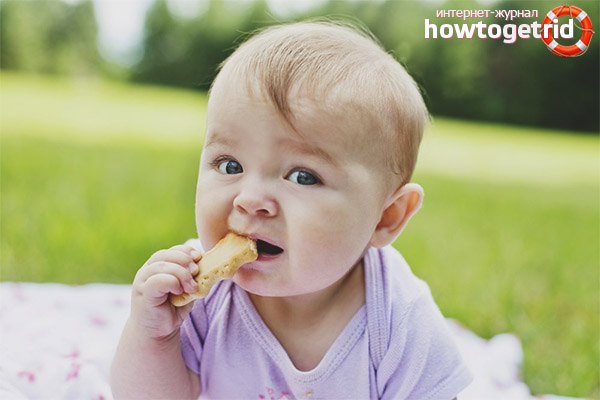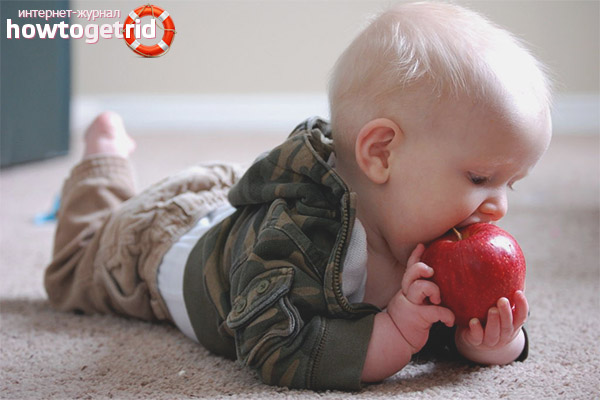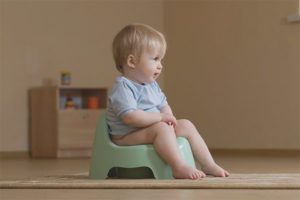The content of the article
From birth, the baby not only grows, but also develops, develops new skills every day, learns to roll over, sit, crawl, stand on its legs. Also, in stages, the baby learns to eat from a common table. So that the child does not have problems with the work of the gastrointestinal tract, so that he eats in a balanced and proper way, the process of training should take place gradually. First, the baby is offered complementary foods - at about 6 months old, unobtrusively, otherwise the child will not develop an interest in food. Milk cereals, vegetable and fruit purees are introduced into the child’s diet. All food should be homogeneous so that the crumbs do not choke. But sooner or later, mothers begin to think about when to introduce solid pieces into the baby’s diet? How to do it safely so that the baby does not choke? What if the child refuses solid food and just spits it out? You can find answers to all these questions in this article.
When to teach a child to chew solid foods?
Chewing skill is not a congenital reflex; it is acquired with age. The ability to chew solid pieces of food is very important for a child. The correct operation of the jaws and language control perfectly develops speech abilities. When a baby actively moves its jaws, gastric juice is produced, food is better absorbed. And also the regular load on the jaw is the formation of the correct bite.
Learning how to chew slices of solid food is very difficult at once; it is a long and step-by-step process that requires patience on the part of parents. From the very beginning of feeding, the baby is offered vegetable puree or porridge. The consistency of the product is uniform, but thick. Now the child needs to work and work his tongue to swallow this porridge. Next, the mother should gradually leave tiny pieces in the food. That is, at 8-9 months it is perfectly acceptable to leave in the puree pieces of vegetables or fruits the size of a match head, which the baby should chew. It is believed that in a year a child should already be able to chew small pieces of vegetables, fruits, bread and cookies the size of peas. Gradually, the baby moves to the common table, he is offered larger pieces of food - pasta, potatoes, etc. As for meat, you should not expect that the baby will be able to chew a whole piece of boiled beef. It will be much easier for the child if it is minced meat, from which mom prepares meatballs or meatballs. It is believed that by the age of two the child already knows how to chew completely, switches to the general table and does not differ in this sense from adults. If by the age of two the baby has not learned to fully chew food, it is worth contacting the doctors - a gastroenterologist, orthopedist, perhaps it is the work of the gastrointestinal tract or the problems of the development of the jaw system.
How to teach a child to chew solid food?
Every child needs to be taught, step by step, this is the main responsibility of parents. And it depends only on you when the baby learns one or another skill. In the struggle for chewing food, there can be many problems that we will try to deal with together.
After 8 months, the child can be offered familiar vegetables and fruits in Nibbler. Nibler is a modern device, which is a mesh of silicone or nylon fabric. A large piece of food (usually a fruit or vegetable) is placed inside the net, after which the bag is tightly closed and fixed on a convenient handle. The design is absolutely safe - you can safely give the baby. The child sucks and chews a bag from which fruit comes out in the form of juice or small pieces, usually the kids like this pastime.But most importantly, this is a safe way to teach your child to chew and tighten his gums.
After 8 months, you can accustom your child to solid food, namely, give him cookies. But not ordinary, but special children's. It quickly soaks, does not get stuck in the throat, very soft and gentle. As a rule, kids love such a treat.
Mom must every day monitor what she cooks and how she does it. That is, with age and each new month, you need to increase the size of large particles in the baby’s food. First, you can grind food using a blender, then use a fork for this, leaving ever larger pieces. If you can’t track it, just use ready-made canned mashed potatoes. Each package indicates the age for which this portion of food is designed. The older the child, the larger pieces of fruits and vegetables remain mashed.
Another way to safely feel bits of solid food in your tongue is by soaking bread. That is, you just need to put slices of bread in the soup, they will not get stuck in the throat, but the baby will have to work hard to chew these lumps.
Surprisingly, children who are accustomed to a common table through pedagogical feeding do not suffer from the problem of inability to chew. The principle of the technique is the introduction of adult food in pieces. That is, the baby sits on his mother’s lap, and if he is interested, he can take small pieces of healthy food from her plate - boiled vegetables, cereals, etc. This is a completely different method of feeding, which also has a right to exist.
Sometimes children can’t chew, just because their teeth have not yet grown. Remember, to accustom a baby to solid food is only when the child has 8-10 teeth.
In the process of mastering the skill, it is important to know the most important rule - take your time and NEVER leave the child alone with food. The baby can choke, a piece of fruit can get into the wrong throat, the baby can suffocate very quickly, this is extremely dangerous. It is better to do everything gradually and not give the baby in 7-8 months a piece of bread or an apple.
Why does the child not want to chew solid food?

It happens that a child who is more than a year old does not want to chew, literally chokes on pieces, they cause a gag reflex. As a rule, this is the absence of gradual accustoming. If the baby is choking, most likely he is simply unfamiliar with solid food and he was constantly fed only mashed potatoes. In fact, this happens very often - the mother does not want to fight a capricious child, she just wants the baby to finally eat. This happens from time to time, the child grows, but does not accustom himself to adult food. In this case, you can go for a trick, because the kids after a year already understand quite a lot. Tell us that the blender has broken and the jars of mashed potatoes have run out. Invite the baby to chop pieces of boiled vegetables himself - give a plastic fork. Of course, the child will not be able to chop qualitatively. But sometimes hunger, combined with interest and curiosity, brings wonderful results - the child gladly puts small pieces on the fork and sends them into his mouth. And it does not matter that half the contents of the plate will be on the floor - this is a completely different problem, which you will deal with later.
To teach a child to chew solid food is not difficult, but it will take a lot of time and patience. Try to have lunch next to the baby - put food in front of him and sat down to eat next to it. Firstly, it will teach the child to eat with his own spoon, and secondly, the baby will see how you chew the food. Thirdly, it will add independence to him, he will choose the size of pieces that he can chew and eat. As they say, patience and work will grind everything!
Video: how to teach a child to chew










Submit